Farmer Focus: More efficient cow type is a work in progress
 Jonathan Hughes © Tim Scrivener
Jonathan Hughes © Tim Scrivener Waterlogged paddocks, failed crops and full lagoons are a common sight. Some of the harvested beet land remains undrilled and what was drilled is patchy. Spring cropping will have to be the answer.
We may try direct-drilling some spring peas into the established combinable oats we grow for feed to reduce our reliance on ever-volatile markets for organic imported proteins.
All stock are still inside. We will graze as soon as conditions allow, hopefully without causing excessive pasture damage.
On the plus side, a relatively mild winter has kept grass growing. We have a high average cover of 2,600kg/ha dry matter for turnout.
See also: How milk solids increased from fine-tuning genetic selection
Grazing high covers with tender soil conditions is always tricky, and we will have to accept some wastage.
But on-off grazing, regular shifts and back-fencing will ensure intakes are met – and hopefully limit damage.
Luckily, a weather window in February allowed us to get a small dose of slurry on silage land via umbilical. Grass is showing a good response already.
Overall, the herd has milked better this winter, peaking at 2.2kg milk solids a head in early December – 10% up on last year.
Although we’ve fed 1.5kg more concentrates since housing, more of this has been home-grown cereals, which has consequently lifted margin.
The improvement is likely down to transitioning cows better and better fertility allowing us to cull or not breed from the poorer quartile of the herd.
For the past four years, we’ve ranked the herd on a matrix based on production, cell count and fertility.
For the past two, we have weighed the herd in January to measure efficiency based on milk solids production per kilogram of liveweight.
Average cow weight is 577kg, and milk solids production is about 590kg a cow, which for our system (that feeds 1.4-1.5t/year of parlour cake) we think is OK.
We have been cross-breeding from a Holstein-Friesian base for 20 years. Originally, we started with New Zealand Friesian, then a three-way cross based on Swedish Red and Kiwi-cross.
About 10 years ago, we had too much Jersey blood and cows were perhaps too small in stature for an autumn-calving cow.
As autumn calvers, our limitation is cubicle spaces so milk solids output needs considering as much as a fertile cow that can walk 6km to graze.

